Over the years I’ve gotten tons of winter sowing questions. I see many of the same ones come through, so I decided to put together an FAQ (frequently asked questions) post to answer the most common ones.
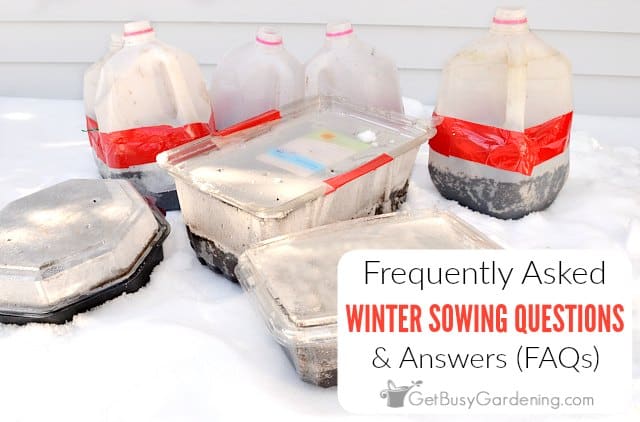
I get tons of questions about winter sowing, so I decided to put together an FAQ guide. This is where you can find the answers all in one simple place.
Below I’ve listed out the main questions I get asked, or the ones I hear most often, along with details to answer each one.
But before digging into the FAQs, I wanted to give you a list of resources where you might find the answer to your most burning winter sowing questions (if you can’t find it in this post).
Finding The Answer To Your Question
If you’re brand new, or aren’t familiar with this technique, then start by reading my quick-start guide. There you learn all about it, and how to get started.
Here are more articles that address many other common winter sowing questions…
- When To Start – If you’re wondering about the timing: when to begin, if it’s too late to start, or when to stop, then read this article.
- What Types Of Containers To Use – If you’d like to learn more about all the different materials you can use to make the mini greenhouses, then check out this guide.
- Which Seeds Work Best – If you’re unsure about which types of seeds will work, or you’d like a list of the best ones to get you started, you can get the details full list here.
- What Type Of Soil To Use – If you’re wondering which kind of soil to use (and what ones to avoid), you can read all about that here.
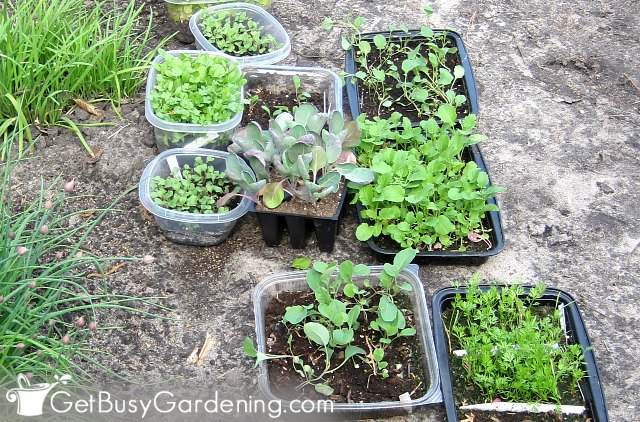
Frequently Asked Winter Sowing Questions & Answers
Below is the list of frequently asked questions about winter sowing that I get the most often.
If you can’t find yours here, make sure to check out my full list of articles here first. Otherwise, you can ask it in the comments below.
Can I put my mini greenhouses in my porch instead of outside for the winter?
If the porch is screened in, they should be fine for the winter. But if the porch has windows, be careful of premature sprouting because of the greenhouse effect.
Also, since the containers won’t be outside, you will have to check on them, and water more often to make sure they don’t dry out.
You may also have to take an extra step to harden them off if it’s really warm in the porch.
How many seeds should I plant in each container?
You don’t want the seeds to be planted too close together, because that will make it more difficult to separate the seedlings.
But you don’t have to worry too much about spacing, since they won’t stay in the containers for too long.
As a general rule, I usually try to space my seeds about an inch apart. I give a little less space for small seeds, and I give the larger ones a bit more room.
Sometimes I plant them closer together if I have a few left over. For tiny seeds, I just sprinkle them over the top of the dirt.
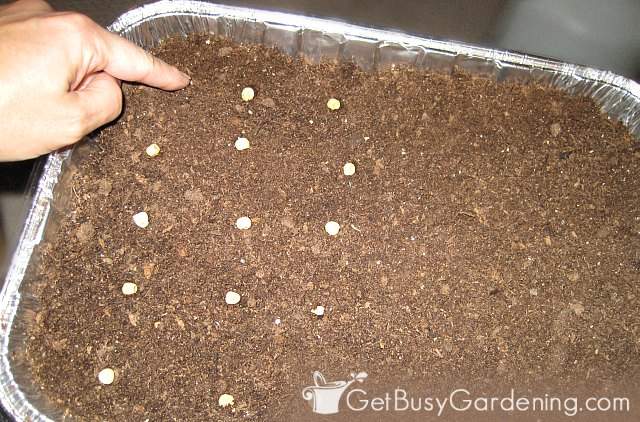
Will my seeds germinate in cold weather?
No. As long as it stays below freezing, your seeds will not germinate. It sounds funny, but they are programmed to know when it’s safe to start growing.
Won’t the constant freezing and thawing through the winter harm my seeds?
As long as you use the correct type of seed, then no. Winter sown seeds are going through the same treatment as the seeds that have sown themselves naturally in the ground.
In fact, some seeds even benefit from the freezing and thawing. It breaks down their hard outer shells, so we don’t have to worry about nicking them. And many of them even need the cold to grow.
Can I winter sow seeds in Dixie cups, toilet paper rolls, or egg cartons?
In case you’re not familiar, the idea is that the paper will make it easier to separate the seedlings in the spring. And that they will work as plantable pots that decompose in the garden.
I have experimented with this before, and found it didn’t work very well. The paper wicks water away from the soil, and dries it out very quickly.
Also, mold can grow on the paper, which is not ideal. Plus, the paper was so brittle by spring, it disintegrated and did not make it easier for me to separate the seedlings.
You could certainly try it to see how well it works for you. Just keep a close eye on the soil moisture level. If wicking becomes a problem, either remove the paper that’s sticking out, or cover it with more soil.
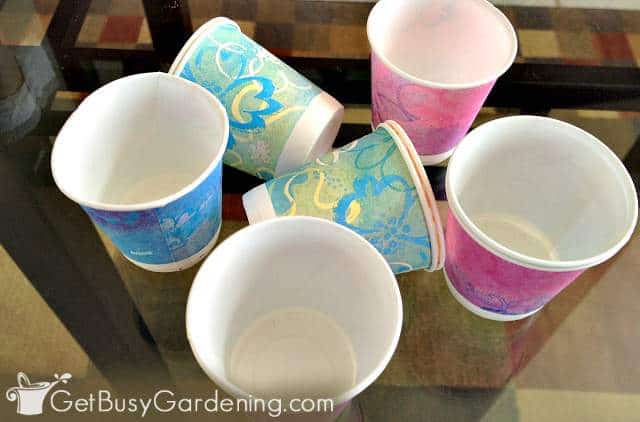
What should I do with my containers if it snows?
Nothing, let them get covered by snow. Don’t worry, it’s all part of the process, and it’s not going to crush the mini greenhouses or harm your seeds.
It’s nice because, as the snow melts, it will seep into the containers, keeping the soil moist.
In the spring after the snow melts off my containers, I go out there once in a while and toss more snow on top. That makes it super easy to water them.
Do I need to protect the containers from harsh cold if we don’t have snow to insulate them?
Nope. Put them out there in the freezing cold… and forget about them until spring. That’s the beauty of winter sowing!
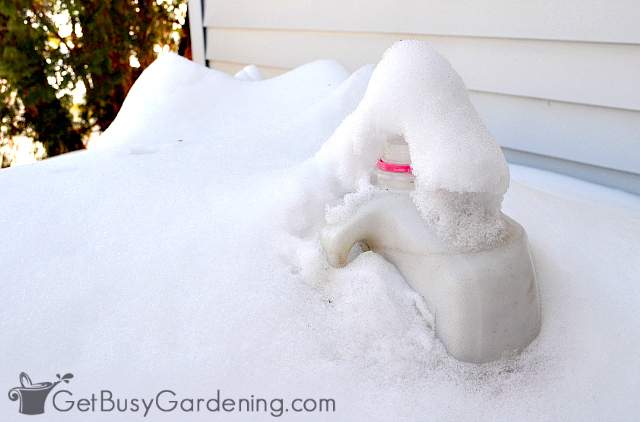
We have a big problem with squirrels and raccoons, will they bother my containers?
We have squirrels and raccoons too, and I’ve never had a problem with them getting into my containers.
If you’re too nervous to winter sow because of this, try putting out a few test containers, and see if any critter bother them.
I would think that since they are closed up tight, the critters will leave them alone. You could always leave the lids on your containers until you’re ready to plant the seedlings into the ground.
How do I water the containers?
If the containers are flat on top, you can just throw snow over them, or pour water onto the lids. This way, the water will trickle in through the vent holes.
For milk jugs, or similar containers, you can tilt them and slowly pour water into the top so it will trickle down the inside. If you pour water directly into the jug, you can displace the seeds or small seedlings.
If the lids are easy to remove, you can open them and water them like you would any other seedlings. But, this can be a big chore when you have lots of containers.
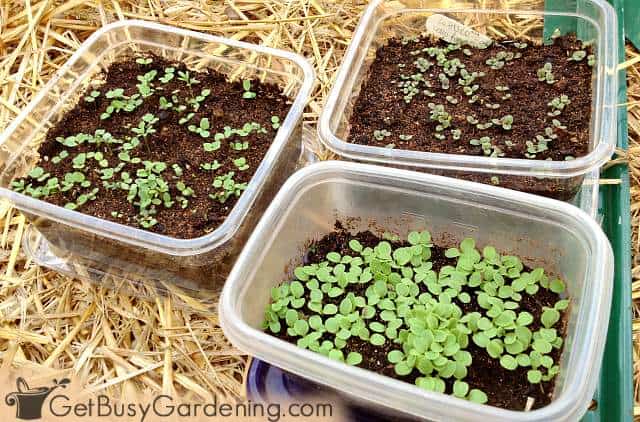
Should I be worried the mini greenhouses are getting too hot in the spring?
Yes. In my experience, this can be a problem. Those mini greenhouses can get pretty hot inside, and the seeds/seedlings could bake if you leave them in the full sun.
So, once it starts getting warm in the spring, you should protect them from the intense afternoon sun. You don’t want them to be in the shade all day, morning and/or evening sun are ideal.
Put your containers under a tree or shrub, or next to a fence, shed, or the house… anything that can provide some shade in the afternoon.
If a full sun location is your only option, then either add more holes in the top of the container, or open the lids to vent them.
Some of my seeds have germinated, but others have not, should I be worried?
Don’t worry, all of your seeds will not germinate at the same time. This is totally normal! Every type of seed is different, and some take longer to grow than others.
Germination rates will also likely vary from year to year. If it’s a warm spring they will germinate faster. If it’s cold, it will take longer. My best advice here is to be patient, and give it time.
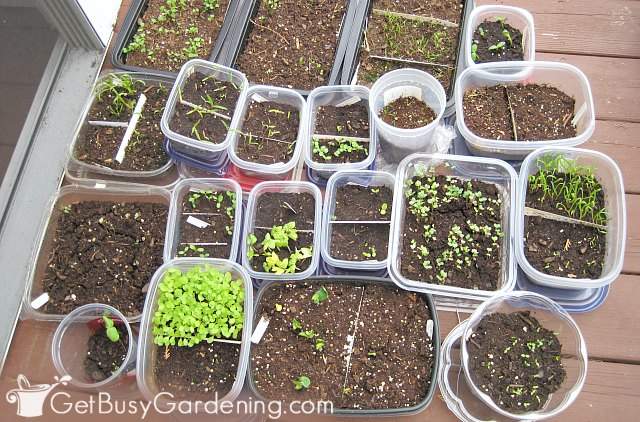
My seedlings are getting tall. Should I take the tops off or leave them on?
You can leave the tops on as long as you want, or take them off whenever you want. Some people leave the lids on until the day they plant the seedlings into the garden.
I take the lids off when the seedlings are outgrowing their containers. Sometimes I’ll take them off on a sunny day if I feel like it (which is not required), then I put the lids back on at night.
There are a few things to keep in mind once you remove the lids. If the seedlings are small, you should protect them from heavy rain.
Also, once the lids are off, the soil will dry out much quicker. So you’ll need to check on them at least once a day, and keep them well watered.
What should I do with the seedlings if it’s going to freeze?
Cold hardy winter sown seedlings can tolerate freezing temperatures, and shouldn’t need to be protected. Just keep the lids on your containers overnight, and they will be fine.
It’s the warm weather plants (the ones that can’t tolerate frost) that you’ll need to worry about. So you might want to give those seedlings a little extra protection to be safe.
Put the lids on the containers, and then cover them with a blanket. Or you could move them into the garage or a shed if that’s easier.
Last year I had all my lids off, and everything was growing great. Then one night in May, they were predicting a late freeze (ugh!).
I couldn’t put the lids back on because my seedlings were too tall, so I covered them with a blanket (and prayed!).
Sure enough, the blanket was covered with frost the next morning. But, even without their lids, my seedlings were just fine under the blanket. Whew!
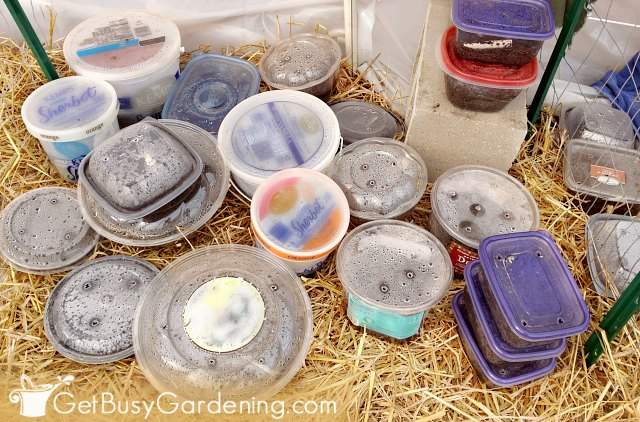
Hopefully this post answered all of your winter sowing questions. If not, you can go ahead and ask away in the comments below. Otherwise, click through the links to the articles at both the top and bottom on this page to find more information.
If you want to learn everything there is to know about winter sowing, then my Winter Sowing eBook would be perfect for you! It has all the details and steps you need to be a successful winter sower. Download your copy today!
Otherwise, if you want to learn all the different methods to grow any type of seed you want, then you should take in my Seed Starting Course! It’s a comprehensive, self-paced online course, and it’s lots fun too! Enroll and get started today!
More Winter Sowing Posts
- How To Prepare Containers For Winter Sowing
- Tips For Winter Sowing During A Mild Winter
- How To Clean Winter Sowing Containers For Reuse
Do you have any burning winter sowing questions? Go ahead and ask them in the comments below.
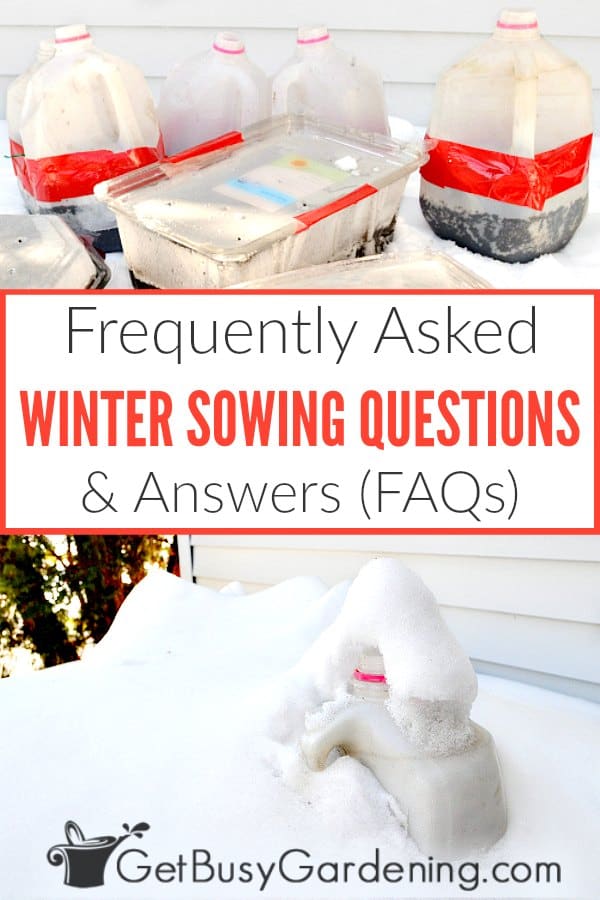
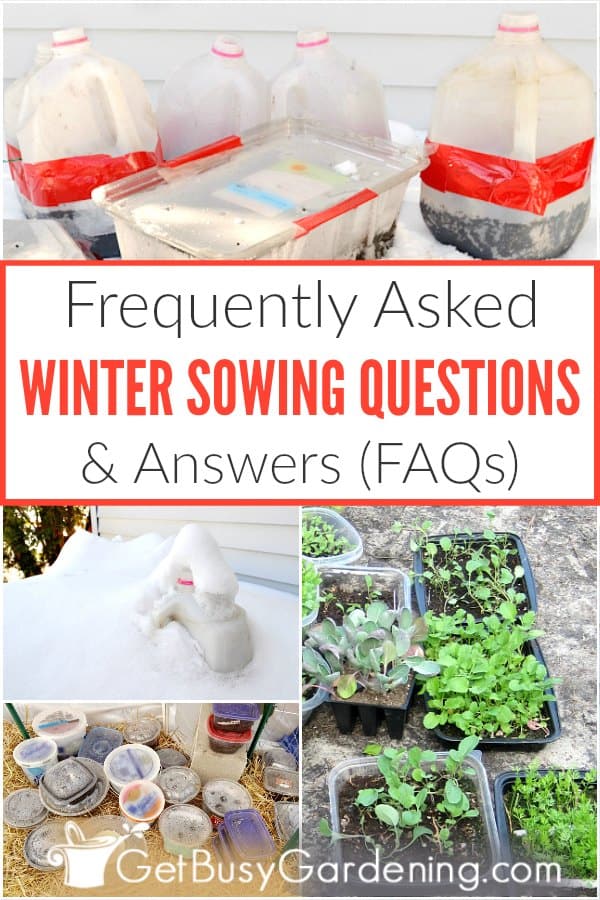
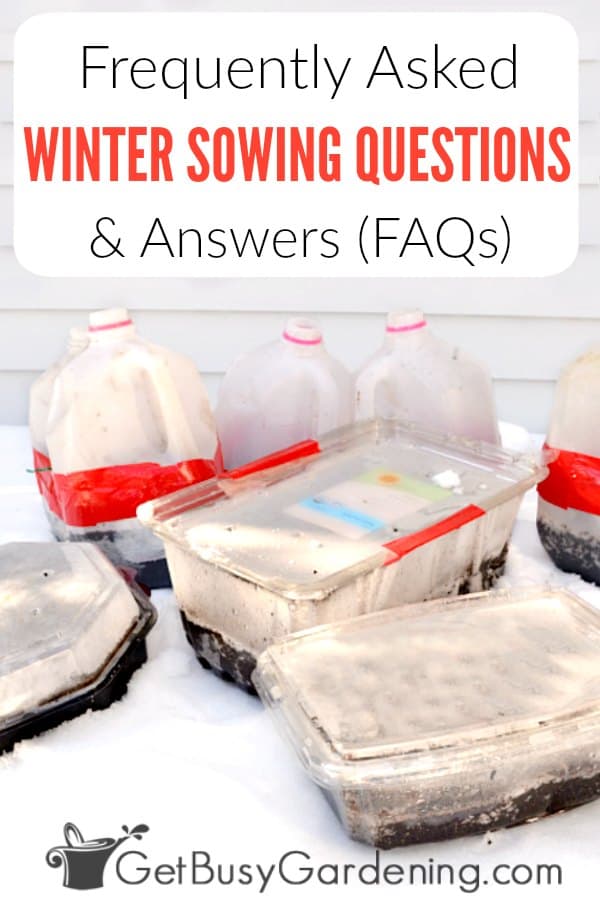

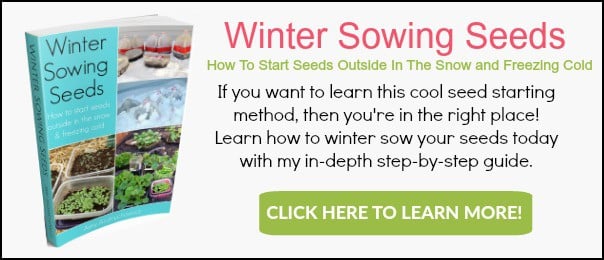

Nettie says
Hi! I live in south central Texas & I just heard about winter sowing a few weeks ago. I never had good luck with starting seeds so I thought I would try this out. I have started some containers but I was wondering how this works in my zone 9 & should I have started earlier.
Amy Andrychowicz says
Great question. I would definitely recommend starting earlier next year in your zone.
Tami says
Okay so it’s almost January here in zone 6 and I have the urge to sow outdoors, on the ground, some onion seeds. Ground hasn’t been frozen for a week and temps are staying around 6 Celsius… could I do it? Like as long as the ground is workable it wouldn’t matter if temps go below freezing again this coming week?
Amy Andrychowicz says
Depending on where you live, the onion seeds may survive the winter in the ground and germinate in the spring. But winter sowing them will definitely make the sprout faster, giving you a better head start.
Kathleen Roscoe says
I am confused about the containers. You state that the containers have to be transparent, but then you talk about ice cream containers and milk jugs which are not transparent, but translucent. Could you please clarify? I really am enjoying your posts. I am in Wisconsin, zone 5 and it is nice to read articles from someone else who loves gardening in a colder zone. Thanks for all the great info. Also I am considering buying your e book but can’t find a price.
Amy Andrychowicz says
Thanks for your question. You can use transparent OR translucent containers – as long as they let light in, they will work for winter sowing. Here’s more information about choosing the right WS containers.
Robin says
I have an unheated greenhouse (zone 3) and I want to start winter sowing of some seeds. Do the containers still need to be covered in a protected greenhouse or will they be fine with no cover?
Amy Andrychowicz says
You don’t need to use the winter sowing method if you have a greenhouse. You can simply direct sow the cold hardy crops right into your garden beds as soon as the soil is workable.
Megan says
It is The end of April right now I have some crookneck and watermelon ready to be planted. Once I plant them do I need to cover them with like top of a milk jug or wall of water until the last frost?
Amy Andrychowicz says
Squash and watermelon plants don’t like the cold at all, and planting them early is not beneficial. It’s best to wait until the air temperature stays consistently above 60°F, and the ground is 70°F before planting them, or the cold will stunt their growth.
Megan says
Ok that is good to know thank you.
Amy Andrychowicz says
You’re welcome.